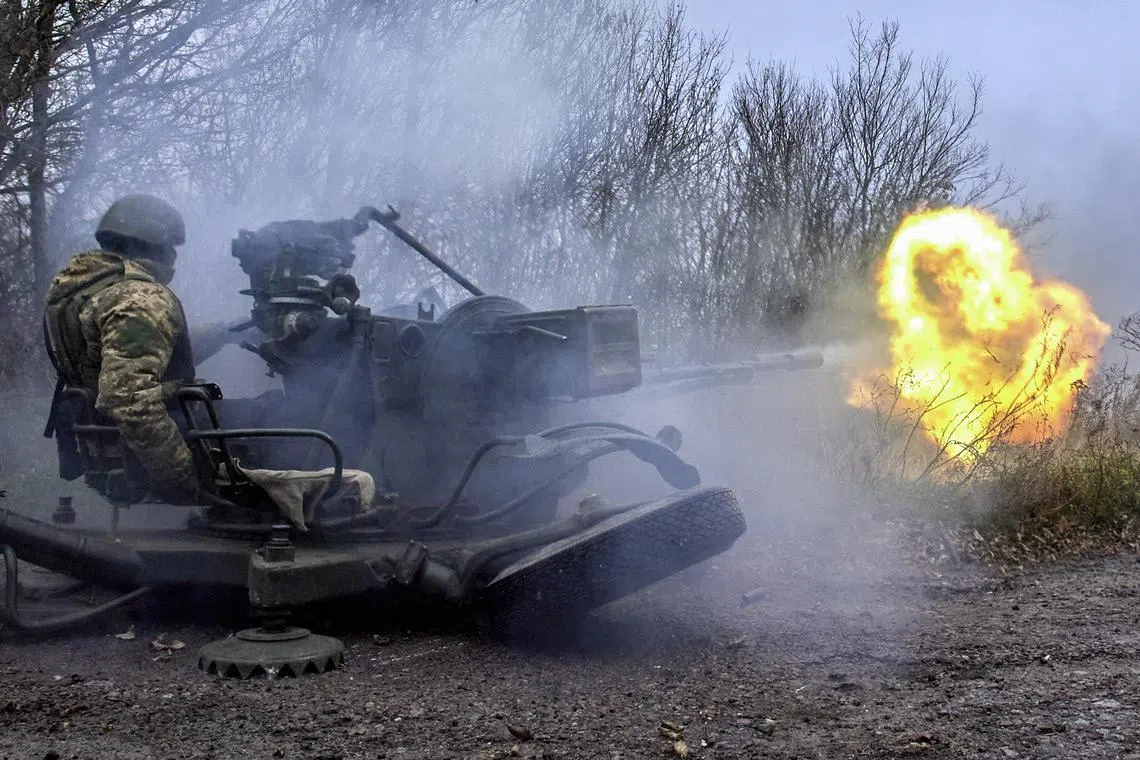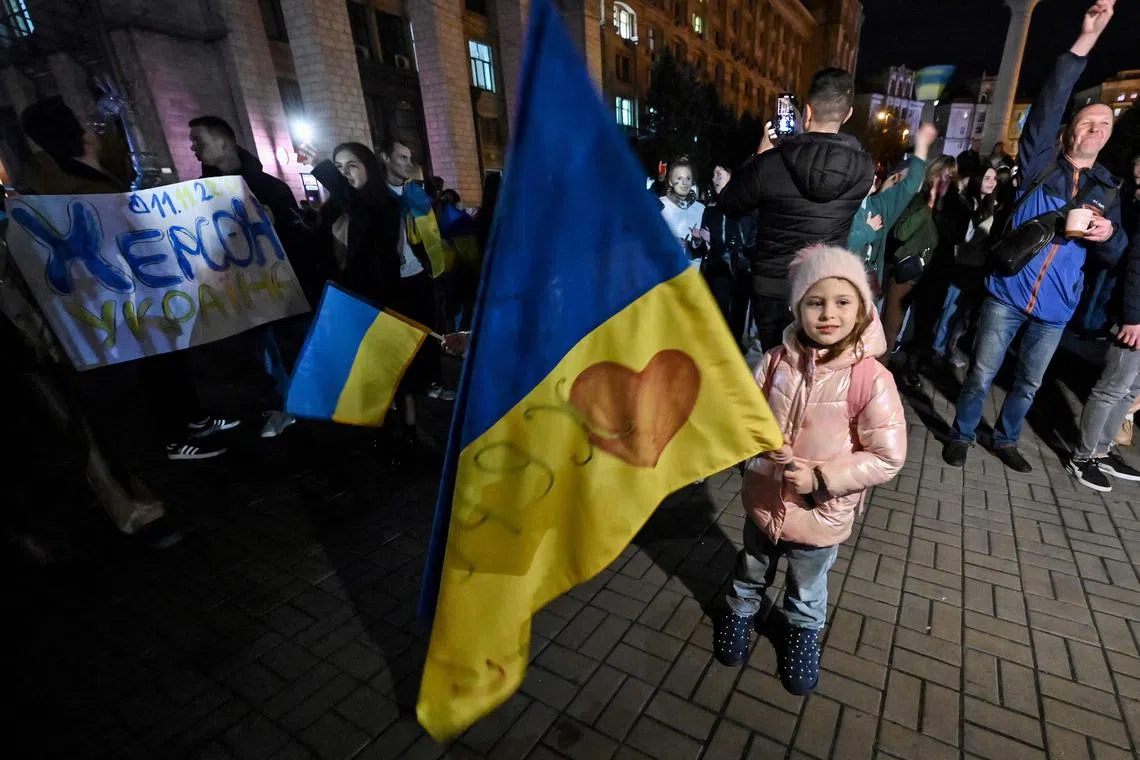Ukraine signals it will stay on the offensive, despite talk of a lull
Sign up now: Get ST's newsletters delivered to your inbox

A soldier with Ukraine's National Guard fires an anti-aircraft gun at a position not far from Kharkiv, in north-eastern Ukraine.
PHOTO: EPA-EFE
Follow topic:
KYIV – As jubilant Ukrainian troops hoist their national flag over Kherson
In the east, Ukrainian forces continue to grind forward and have repelled repeated Russian efforts to seize towns like Bakhmut and Pavlivka, reportedly killing hundreds of Russian soldiers. In the south, they are striking deep behind Russian lines, hitting Moscow’s troops before they can settle and build defences on the eastern bank of the Dnieper River, across from Kherson.
And there are growing hints from troops on the ground, and volunteers close to them, that the Ukrainians are preparing for a new land offensive between those two fronts, southward through the Zaporizhzhya region toward Melitopol, challenging Russia’s hold on the entire southern area that it seized in the invasion that began in February.
“The logic of war is not to pause and somehow continue to move forward,” said Senior Lieutenant Andriy Mikheichenko, commander of an anti-tank unit defending the embattled town of Bakhmut, in the eastern Donbas region. “I think there will be counterattacks in other directions, so that the enemy does not have time to transfer reserves and block strikes.”
Many analysts and diplomats have talked about the war entering a period of stasis during the cold of winter, with both militaries needing to rebuild. Some leaders – most notably, General Mark Milley, chair of the US Joint Chiefs of Staff, on Thursday – have suggested that a lull in fighting would be a good time for talks.
But the government in Kyiv, Ukraine’s capital, has been adamant that a stalemate would simply cement into place Russian gains, suggesting that, even if conditions force Ukraine to slow its offensives, it does not plan to stop them.
There has been a chorus of conflicting predictions by military analysts and others, inside and outside Ukraine, about what to expect next, and Ukrainian soldiers often delight in the military command’s ability to obscure its intentions and keep everyone guessing.
Turning up the heat
The drawing of a new front line at the southern reaches of the Dnieper, with the two sides controlling opposite banks, will essentially bring a halt on the Kherson front, military analysts said. The river’s immense width and further damage to the main Antonivksy bridge by departing Russian troops make it extremely difficult and risky for Ukrainian troops to try to pursue the retreating Russian forces across the water.
There was evidence that Ukraine was continuing to strike deep behind Russian lines, with reports of rocket strikes on Russian forces regrouping in several locations along the eastern bank, and of strikes in recent days on the southern cities of Melitopol and Henichesk, near the Black Sea coast, more than 60km from the front.
Ukrainian special forces and partisan forces will maintain a steady momentum of small-scale attacks behind Russian lines, said Mr Justin Bronk, a senior research fellow in military sciences at the Royal United Services Institute, a defence analysis organisation in London.
One camp of commentators, made up of former Western military servicemen who follow the war closely and cite friends among those fighting, is already predicting that Ukraine will make further gains in the south, as Russian morale and organisation unravel.
“A good day, my friend. Now we move on to other maps and other battles!” a former member of the US Navy SEALs, Mr Chuck Pfarrer, tweeted on Friday as Ukrainian troops swept into Kherson.

A child holds a Ukranian flag as people gather in Maidan square to celebrate the liberation of Kherson, in Kyiv on Nov 11, 2022.
PHOTO: AFP
Speaking on Twitter Spaces this week with the Mriya Report, a popular pro-Ukraine organisation, Mr Pfarrer said he thought the city of Melitopol was the next target to watch and spoke confidently of Ukraine’s ability to press its advantage and recapture more territory in coming months.
Other analysts were more cautious.
Mr Bronk said he expected both sides to take an operational pause because of the difficulty of muddy, wet and cold conditions, and because the fighting in Kherson had been extremely debilitating. He predicted that full-scale fighting would resume in the spring.
Ukraine’s next targets, he said, would most likely be either in the direction of Melitopol in the south or in the east, continuing the offensive that routed Russian forces from the Kharkiv region, to recapture the town of Svatove in the Luhansk region, which has been the focus of fighting for the past month.
But he doubted that Ukraine had the concentration of forces to mount a large-scale offensive action, which, according to military convention, usually demands that attackers far outnumber defenders.
“I would be surprised if they have the ammunition, fuel and equipment to do it,” he said, adding, “There have been massive casualties on the Kherson front.”
Next phase will again be ‘extremely brutal’
Gen Milley said on Thursday that Russia and Ukraine had each suffered more than 100,000 casualties – dead and wounded – in less than nine months of warfare. Neither side has published official casualty figures amid strict control of information.
The commander of a volunteer battalion in the Zaporizhzhya region confirmed that Ukrainian casualties were high. He said he knew of one unit that was losing 20 men a day in eastern Ukraine, and he estimated that his country was still losing from 100 to 200 men a day overall, as it had been earlier in the year when President Volodymyr Zelenskyy first mentioned that rate.
One thing analysts agree on is that, whether or not there is a pause, the next stage will again be extremely brutal.
“The war will not stop in the coming winter,” Mr Mick Ryan, a recently retired Australian army major-general, wrote in an article for ABC of Australia.
“But it will be fought at a different tempo,” he added. “And it provides political and military leaders an opportunity to plan for what is likely to be a brutal and bloody year ahead.” NYTIMES

